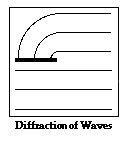Diffraction
Diffraction and interference are the same phenomenon, and it is unfortunate that two different terms are used.
Both involve the interaction (interference) of two waves.
These effects occur for all waves, not just light. The term diffraction is used when light passes through a single opening or next to an opaque object and one part of the wave front interferes with another part of the same wavefront.
Because of the wave nature of light and the spreading out of secondary waves, the shadow of something like a razor blade is not sharply defined. Instead, the edge of the shadow is a series of closely spaced light and dark regions.
These are very closely spaced and hard to see with the naked eye.
In a similar fashion, if light is shined through a hole onto a screen, the result is not a single, well-defined spot of light but rather a series of light and dark rings. All of these effects have important consequences.
Types of diffraction
Fraunhofer diffraction: We will consider cases where the incident light rays are parallel (Fraunhofer diffraction). In practice, a lens is used to focus these rays on a screen.
Fresnel diffraction: The case of nonparallel rays (Fresnel diffraction) is more complicated, but it shows the same qualitative features.
Diffraction of Light
Diffraction is the slight bending of light as it passes around the edge of an object. The amount of bending depends on the relative size of the wavelength of light to the size of the opening. If the opening is much larger than the light's wavelength, the bending will be almost unnoticeable. However, if the two are closer in size or equal, the amount of bending is considerable, and easily seen with the naked eye.
In the atmosphere, diffracted light is actually bent around atmospheric particles -- most commonly, the atmospheric particles are tiny water droplets found in clouds. Diffracted light can produce fringes of light, dark or colored bands.
An optical effect that results from the diffraction of light is the silver lining sometimes found around the edges of clouds or coronas surrounding the sun or moon.
The illustration above shows how light (from either the sun or the moon) is bent around small droplets in the cloud.
Reflection involves a change in direction of waves when they bounce off a barrier; refraction of wavesinvolves a change in the direction of waves as they pass from one medium to another; and diffraction involves a change in direction of waves as they pass through an opening or around a barrier in their path.
Water waves have the ability to travel around corners, around obstacles and through openings. This ability is most obvious for water waves with longer wavelengths.
Diffraction can be demonstrated by placing small barriers and obstacles in a ripple tank and observing the path of the water waves as they encounter the obstacles.
The waves are seen to pass around the barrier into the regions behind it; subsequently the water behind the barrier is disturbed.
The amount of diffraction (the sharpness of the bending) increases with increasing wavelength and decreases with decreasing wavelength. In fact, when the wavelength of the waves is smaller than the obstacle, no noticeable diffraction occurs.

